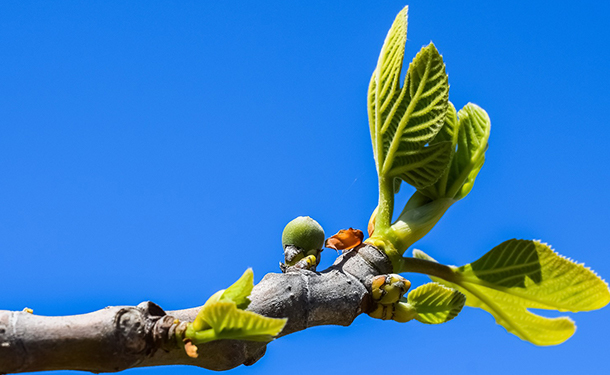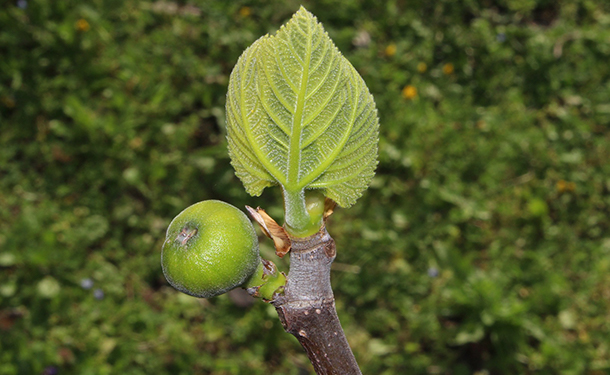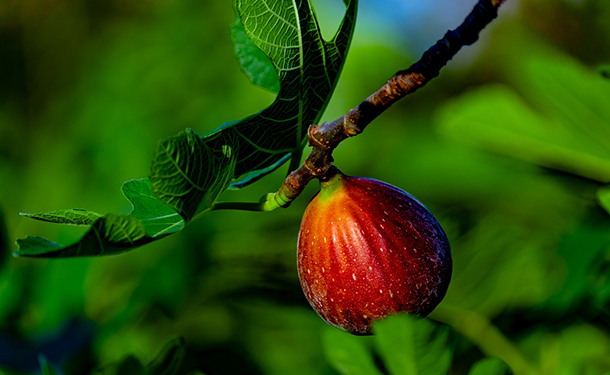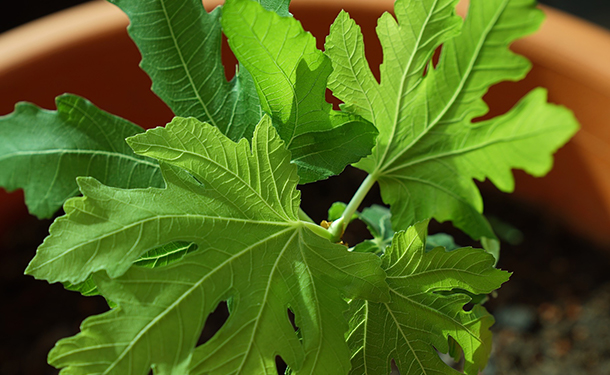Keep your fig tree from wilting and prematurely dying. Knowing how to properly care for a fig tree will help it mature to its full size and bear multiple delicious fruit crops.

thetreecareguide.com gathered essential species, planting, and care information for indoor and outdoor fig trees.
Fig Tree Description
The common fig (Ficus carica) is typically a small tree or large shrub in the mulberry (Moraceae) family with attractive leaves and delicious edible fruits. This deciduous tree grows to a mature size of 10 to 30 feet tall and wide quickly.
Note: The Latin name Ficus translates as “edible fig,” and the species Carica refers to the Caria region in Asia known for growing figs.
Planting Fig Trees Outside
Plant in full sun or partial shade in rich, moist, well-drained soil. Fig trees grow best in zones 8 through 11 but can be grown in zone 7 if planted in a sheltered space. When planted in zone 6, your fig tree may need to be grown in a pot and overwintered inside. This species grows well in containers, but container-grown trees must be overwintered indoors.
Soil Preference – Most fig trees flourish in all types of well-drained soil with a 6 to 7.5 pH. Adding eggshells to the soil provides calcium carbonate, phosphorus, magnesium, silicon, and sodium, all of which will help your fig tree grow better.
Watering – Fig trees need 1 to 1 1/2 inches of weekly water. Check the tree’s foliage; if it starts turning yellow and falling, it’s a sign that your tree needs to be watered. Keep the soil moist but not soaked (around the trunk, extending out to the tree’s dripline). Adding a 2 to 3-inch layer of mulch around the tree can help retain moisture and moderate soil temperature.
Fertilizing – Your fig tree should be fertilized in late winter (before the growing season) and again in late summer. Your fig tree will be prone to diseases and will likely produce fewer fruits if you don’t feed it regularly with the right type of feed.
Use a fertilizer made for fruit trees or an all-purpose 8-8-8 or 10-10-10 fertilizer containing a balance of 8 % or 10% N (nitrogen), P (phosphorus, and K (potassium).
Pruning – You should keep pruning activities in mind from planting your fig tree. Avoid pruning in the spring and fall to prevent fungal infection, and consider the following best practices:

- Prune your fig tree in its first year
- Prune your tree again during the tree’s first winter
- Continue pruning your tree each year
- Select branches to keep as fruiting branches
- Prune out any storm-damaged branches
- Always use sanitized pruning shears
- Prune away any “secondary” branches
- Prune away odd growth and suckers
Tip: Cut back the main fruiting branches by one-third to one-quarter. This helps the tree put more energy towards bearing next year’s fruit, which promotes a more extensive and sweeter crop.
Fruit – Fig Trees typically fruit within the first two to three years after planting. Planting a grafted fig tree may result in fruit within the first year.

Planting Fig Trees Indoors
A single, good-sized tree can easily serve as the centerpiece for a room, while it would take several smaller plants to create the same impact. You can acquire a young tree and keep it pruned to control its size if you have a smaller space. Ficus trees can easily reach ten to fifteen feet indoors or larger if you have high ceilings and sufficient light. Consider the following when growing a fig tree indoors:
Light – Fig trees are tropical plants and require ample bright, indirect sunlight when grown indoors. Most fig trees will thrive in an east-facing window (direct sun in the morning and indirect sunlight for the rest of the day).
Soil and Potting – Well-drained soil is fundamental for keeping a potted fig tree healthy. Select a pot with drainage holes that’s about two to three inches larger than your fig tree’s root ball. Use light, fast-draining soil so your tree’s roots won’t sit in water.
Watering – Fig trees do not like being overwatered. Water your tree when the top three inches feel dry to the touch.
Fertilizing – Indoor fig trees need the proper nutrient balance to grow healthy roots, strong trunks, and beautiful foliage. Fertilize regularly during late winter and late summer with an 8-8-8 or a 10-10-10 balanced fertilizer.
Fruiting – If you want to grow edible figs indoors, plant the Negronne fig (self-pollinating variety). Otherwise, you’ll need two trees or manual pollination.
Note: Container-grown fig trees usually fruit within five years of planting and proper care.

Ficus Carica Planting and Care
In this article, you discovered species, planting, pruning, and care information for growing indoor and outdoor fig trees.
Understanding the best conditions for your fig tree’s growth will help you keep it healthy, thriving, and fruiting.
Ignoring planting, watering, fertilizer, and light requirements for fig trees will leave them wilting, dying, and unable to produce fruit.
Sources:
plants.ces.ncsu.edu/plants/ficus-carica/
public.asu.edu/~camartin/plants/Plant%20html%20files/ficuscarica.html
atlas.uwa.edu/Plant.aspx?id=2677